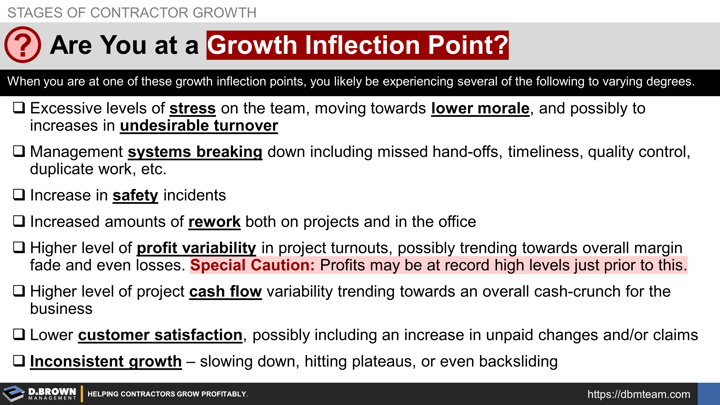Note that these are all lagging indicators. Often the underlying systems have broken down long before some of these outcomes are seen so they appear more like a sinkhole in a busy intersection than as a progressive decline that shows up nicely in a graph. If only one of these is off, and only momentarily, it may truly have been a "Black Swan" event.
In any case, these eight questions are a great starting point.
- Excessive levels of stress on the team, moving toward lower morale, and possibly to increases in undesirable turnover.
- Management systems breaking down including missed hand-offs, timeliness, quality control, duplicate work, etc.
- Increase in safety, theft, or property damage incidents.
- Increased amounts of rework both on projects and in the office.
- Higher level of profit variability in project turnouts, possibly trending toward overall margin fade and even losses. Special Caution: Profits may be at record high levels just prior to this.
- Higher level of project cash flow variability trending toward an overall cash-crunch for the business.
- Lower customer satisfaction, possibly including an increase in unpaid changes and/or claims, no "last looks" at projects, up through customer turnover.
- Inconsistent growth – slowing down, hitting plateaus, or even backsliding.
Tips for diving into these questions:
- Review "Headcount and Stages of Contractor Growth."
- Practice formulating and asking "Good Questions."
- Assemble a good cross-section of people both internally and externally to help you evaluate together and use the "5D Facilitation Process" to ensure alignment.
- Look at both internal trends in data as well as external benchmarks.
- Pay attention to anecdotal and fragmented information as that shows up long before trends in data.
- Leverage experienced but unbiased 3rd parties where appropriate.
If you have questions about any of these or want to have a confidential conversation about your specific situation, please contact us. We exist to help contractors build stronger businesses for the next generation and will freely share anything we know that will help.

